› Forums › General Discussion › Potential visibility of a fuel dump from a rocket booster
- This topic has 12 replies, 3 voices, and was last updated 10 years, 11 months ago by
 Nick James.
Nick James.
-
AuthorPosts
-
12 December 2014 at 8:30 am #573396
 William StewartParticipant
William StewartParticipantDear All,
Just wanted to draw attention to the potential visibility of a fuel dump from a rocket booster.
The launch of the NROL 35 mission has been delayed from 12th Dec 2014 03:17 GMT to 13th Dec 2014 03:13 GMT due to inclement weather at the launch site in California. As highlighted by Cees Bassa (http://satobs.org/seesat/Dec-2014/0071.html) previous similar launches have resulted in a fuel dump occurring 45 to 80 minutes after launch.
Fuel dumps typically result in a short lived, triangular shaped cloud appearing in the sky, looking somewhat like a bright comet. Google “satellite fuel dump” for images.
If NROL 35 launches on time (current weather forecasts are for a 40% chance of launch proceeding at the revised time) then there a chance that the fuel dump from the upper stage could be visible from Europe.
Unfortunately the booster is not expected to rise above the horizon for UK observers until approximately 04:30 GMT (ie 77 minutes aftr launch) and so if the if the fuel dump occurs within a similar timeframe to that noted previously, we’ll only see the (faint) latter stages. Binoculars may be of help; DSLR operators have the advantage of taking a time exposure. Ephemerides below are for different locations in the UK. You’ll note that the object moves much more slowly than satellites in low earth orbit, this being due to the fact that this booster will have placed the payload in a Molniya orbit.
HH MM SS Azimuth Elevation
Essex
04 30 00 099.0603 000.1323 00.0
04 35 00 095.1498 004.7407 00.0
04 40 00 091.6831 008.7675 00.0
04 45 00 088.5747 012.2955 00.0
04 50 00 085.7604 015.3990 00.0
04 55 00 083.1911 018.1418 00.0
05 00 00 080.8286 020.5776 00.0
05 05 00 078.6426 022.7510 00.0Cheshire
04 35 00 093.3335 002.7707
04 40 00 089.9874 006.8185
04 45 00 086.9956 010.3805
04 50 00 084.2933 013.5270
04 55 00 081.8312 016.3187
05 00 00 079.5708 018.8069
05 00 00 079.5708 018.8069North Scotland
04 35 00 094.4931 001.6862 00.0
04 40 00 091.4381 005.9843 00.0
04 45 00 088.7087 009.7872 00.0
04 50 00 086.2435 013.1629 00.0
04 55 00 083.9962 016.1712 00.0
05 00 00 081.9312 018.8635 00.0Weather prospects for much of the British Isles early Saturday morning look good so this is a rare opportunity to see such an event. Operators of meteor video cameras should check meteor detections around the above times to determine if they have captured the fuel dump … the angular speed of the object will be too low to trigger a recording but a meteor will and the “cloud” could be “in the background”, assuming you’re pointing in the right direction.
Keep an eye on Spaceflight Now and on the Twitter feed detailed on the page for the latest on the launch.
Would certainly be worth keeping an eye out for this if you happen to be out under clear skies … and you should see a few Geminids too!
Thanks to Ted and Cees over at SeeSat L for highlighting this opportunity and estimating orbital elements.
Best regards
William
http://www.nemetode.org12 December 2014 at 8:59 am #576700 William StewartParticipant
William StewartParticipantApologies, slight error in the previous post:
” … previous similar launches have resulted in a fuel dump occurring 45 to 80 minutes after launch.”
should have read
“… previous similar launches have resulted in a fuel dump occurring 45 to 80 minutes after the payload is inserted into orbit.”
The upshot of this is that observing conditions improve for UK observers with the dump now expected to commence (and be at it brightest) soon after the object clears the horizon for UK observers.
Best regards
William
12 December 2014 at 5:41 pm #576701 Nick JamesParticipant
Nick JamesParticipantWilliam,
Thanks for posting this. I’ll be setting up a DSLR to cover the predicted area in case the launch goes ahead.
Nick.
13 December 2014 at 6:19 am #576702 William StewartParticipant
William StewartParticipantWe had reasonably clear skies in Cheshire so was worth making the effort to go out to see this event.
The launch was delayed 7 minutes but 05:00 GMT rolled by and I’d still seen nothing – decided to stay out a bit longer to enjoy the meteors when the fuel dump suddenly appeared.
The Centaur upper stage is powered by liquid hydrogen and liquid oxygen and it would make sense to dump the fuel at different times. The first image was taken at 05:09:48 GMT. Just the initial plume is visible:
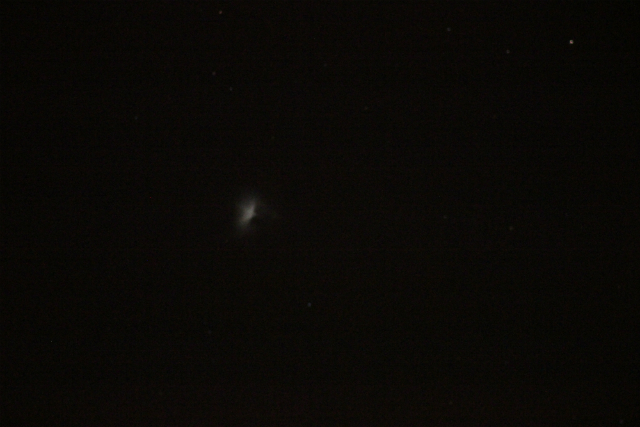
The second at 05:11:14 GMT – the initial plume is fading but the bright dot to the right is the second plume just starting to emerge from the booster:
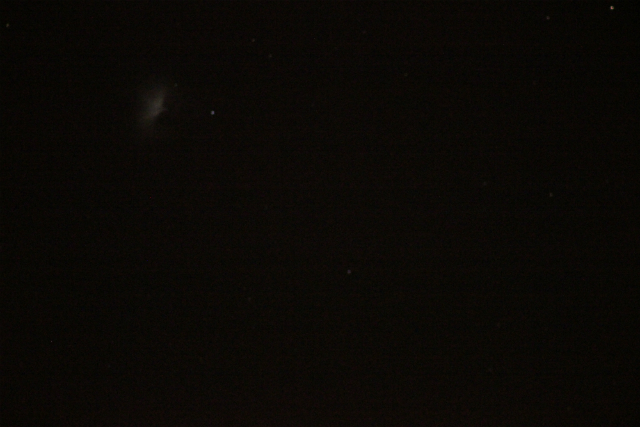
The third at 05:13:30 GMT – first plume contines to fade, second plume getting brighter
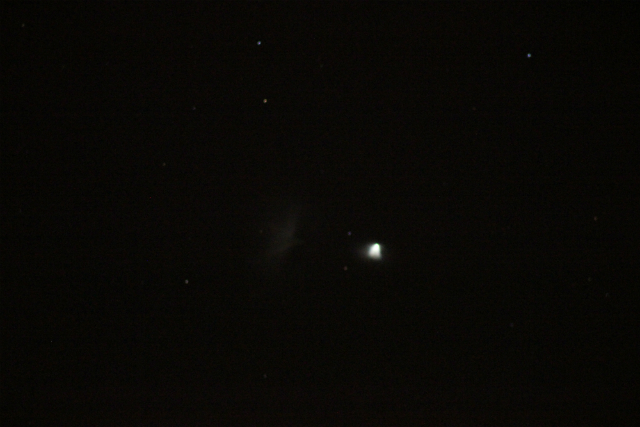
05:19:34 GMT – first plume lost in cloud, structure now visible in second plume
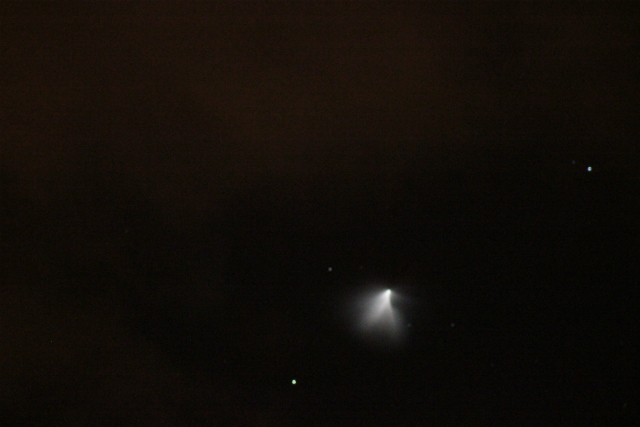
Through occasional gaps in the clouds, the second plume continued to be visible to the unaided until around 05:40 GMT, still expanding, estimate it was around 0.5 degrees in diameter.
Alas the camera focus wasn’t as crisp as I’d have liked it – equipment used was a Canon EOS Rebel T2i with a 75-300mm lens (fully zoomed out to 300mm), ISO 6400, 1 second exposure.
Hope others were able to see this.
Best regards
William
PS Faint smudge from this also visible on video meteor cameras!
13 December 2014 at 6:54 am #576703 William StewartParticipant
William StewartParticipantThe faint smudge just above the end of the meteor trail is the fading plume from the fuel dump, as seen by the Ravensmoor north-east camera.
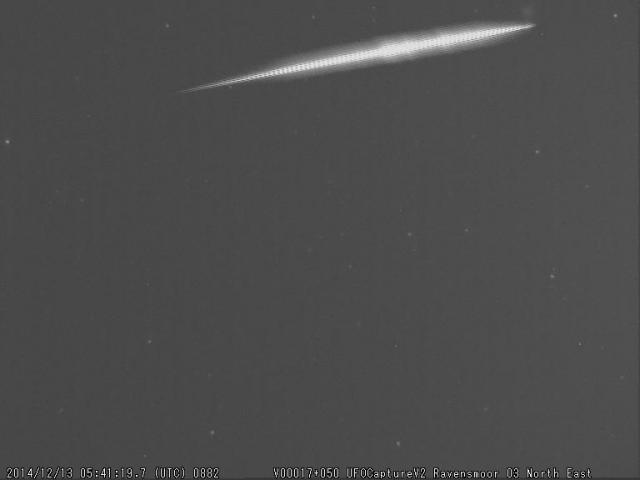 13 December 2014 at 7:16 am #576704
13 December 2014 at 7:16 am #576704 Nick JamesParticipant
Nick JamesParticipantHi William,
Great pics. I was waiting for this in the garden, but although clearish to the north there was persistent cloud in the SE.
I gather that there have been a number of reports of a bright “comet” seen by people out observing at the time. It must have been quite spectacular. Just sorry I didn’t get to see it.
Nick.
13 December 2014 at 8:04 am #576705 William StewartParticipant
William StewartParticipantHi Nick,
Sorry to hear you were clouded out 🙁
I’ve waited many years to see one of these – really glad that I’ve had a chance to witness it (even got the kids up to have a look). It’s a sight I’ll not forget.
Have seen the “fast moving comet” reports and your update 🙂
Reminds me of a few years ago when I saw the shuttle orbiter Endeavor and the jettisoned external tank (see https://www.flickr.com/photos/ws_astrophotography/3724460713/) a few minutes after launch … again, one of those events I waited years to see. Funny thing was, I saw it again on the very next shuttle launch!
13 December 2014 at 6:46 pm #576706 Alex PrattParticipant
Alex PrattParticipantHi William,
Congratulations on recording the fuel dump ‘comet’.
I also captured that meteor on my Leeds_SE camera. UFO Analyser categorised it as a -2.1m December alpha Aurigid, although it was well aligned with the Geminids radiant. I’m sure our dual-station analysis will rank it as a Geminid.
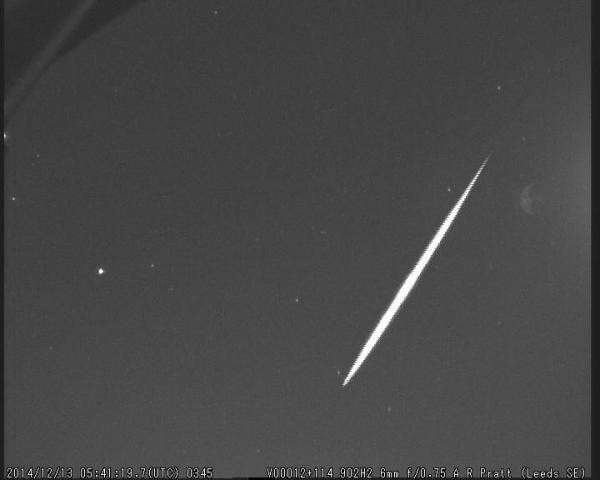
The faint object to the RHS of my meteor trail is not the glow of the fuel dump, it is a ghost image of the Moon, lying outside the FoV.
Clear skies,
Alex.
14 December 2014 at 9:04 am #576708 Nick JamesParticipant
Nick JamesParticipantHere’s my image of that same meteor from Chelmsford. It was classified as a Geminid. I’ll send the details so you can add them to the groundtrack solution.
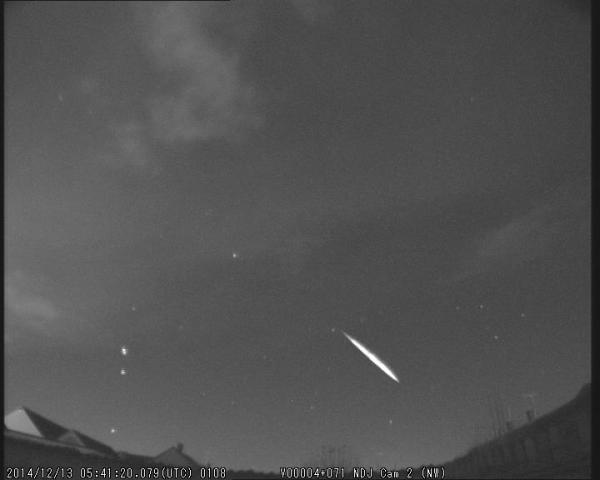 14 December 2014 at 4:28 pm #576709
14 December 2014 at 4:28 pm #576709 Alex PrattParticipantHi Nick,Many thanks for your data.Combining it with William’s data we have a nice Geminid, of absolute mag -2.8, duration 1.62s, detected at an altitude of 101km and extinguished at 58.9km. Its Vg of 32.8km/s and orbital elements are fully consistent with the Geminids stream.
Alex PrattParticipantHi Nick,Many thanks for your data.Combining it with William’s data we have a nice Geminid, of absolute mag -2.8, duration 1.62s, detected at an altitude of 101km and extinguished at 58.9km. Its Vg of 32.8km/s and orbital elements are fully consistent with the Geminids stream.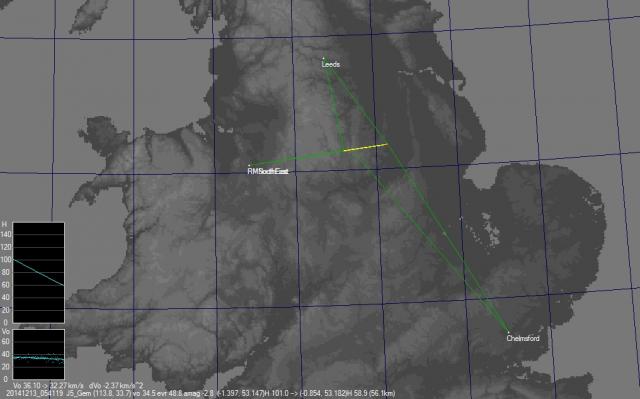
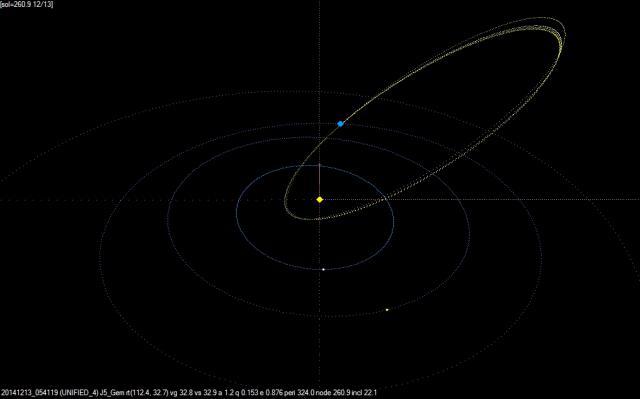 Clear skies,Alex.30 December 2014 at 6:23 pm #576726
Clear skies,Alex.30 December 2014 at 6:23 pm #576726 William StewartParticipant
William StewartParticipantHi All,
Just wanted to draw attention to the analysis by Cees Bassa that makes use of the DSLR imagery from Ravensmoor, plus other observations, to estimate the delta-v imparted to the Centaur booster as part of the CCAM and de-orbit burn. Cees’ analysis includes composite images and an animation and is available here.
Many thanks to Cees for his analysis.
Best regards
William
9 February 2015 at 8:21 am #576791 William StewartParticipant
William StewartParticipantMichael Guinan has been in touch to share a photograph of this fuel dump that he obtained from Waterford City, Ireland at 05:36 GMT on 2014 December 13th with a Canon 1Dx camera fitted with a 24 – 70mm lens. The exposure was 10s at at f/4 at ISO 6400. Below is the original and a crop.
Michael write, “I happened to be out photographing the stars on that morning and witnessed the fuel dump. It was an impressive sight. Although I am a beginner at astrophotography, I managed to capture some nice images of the fuel dump that I’d like to share (see attached). I hope you like them.“
With many thanks to Michael for sharing these (am posting them here on behalf of Michael, with his permission) … great to see a widefield shot like this that puts the observation in context.
William

.jpg) 9 February 2015 at 10:46 pm #576792
9 February 2015 at 10:46 pm #576792 Nick JamesParticipant
Nick JamesParticipantWilliam,
Michael’s pics are excellent. Seeing it in a wide field really shows how bright it was. I wish I’d seen it!
Nick.
-
AuthorPosts
- You must be logged in to reply to this topic.
